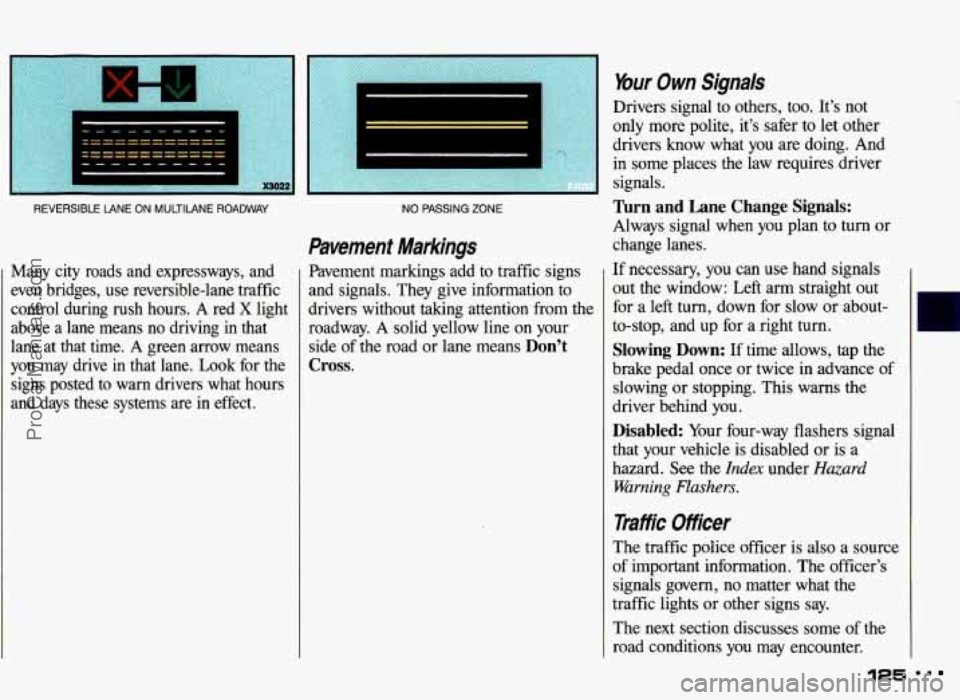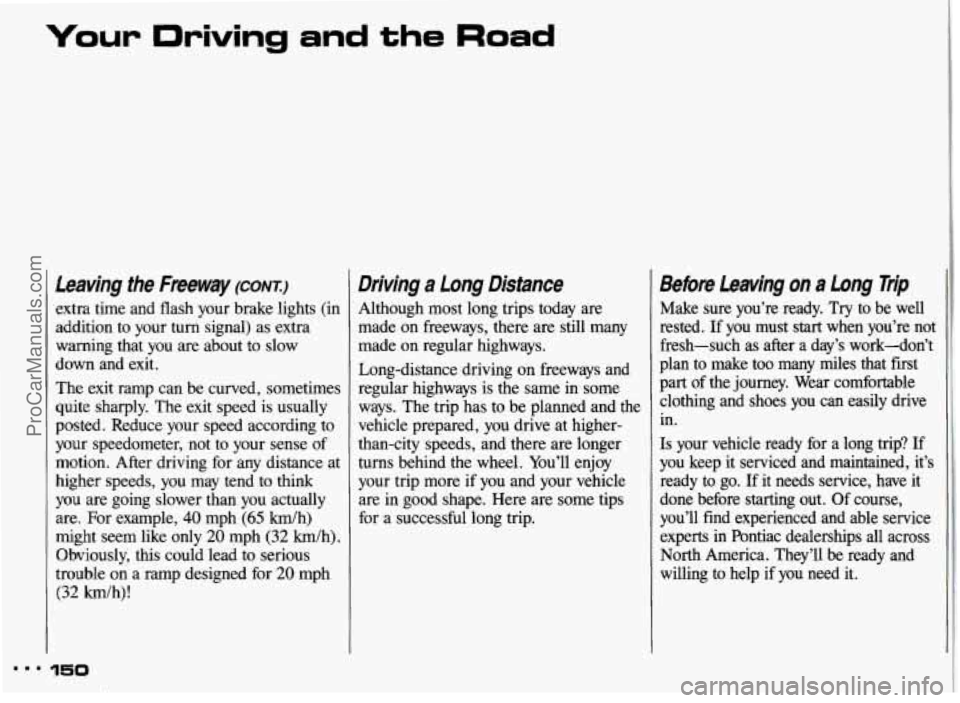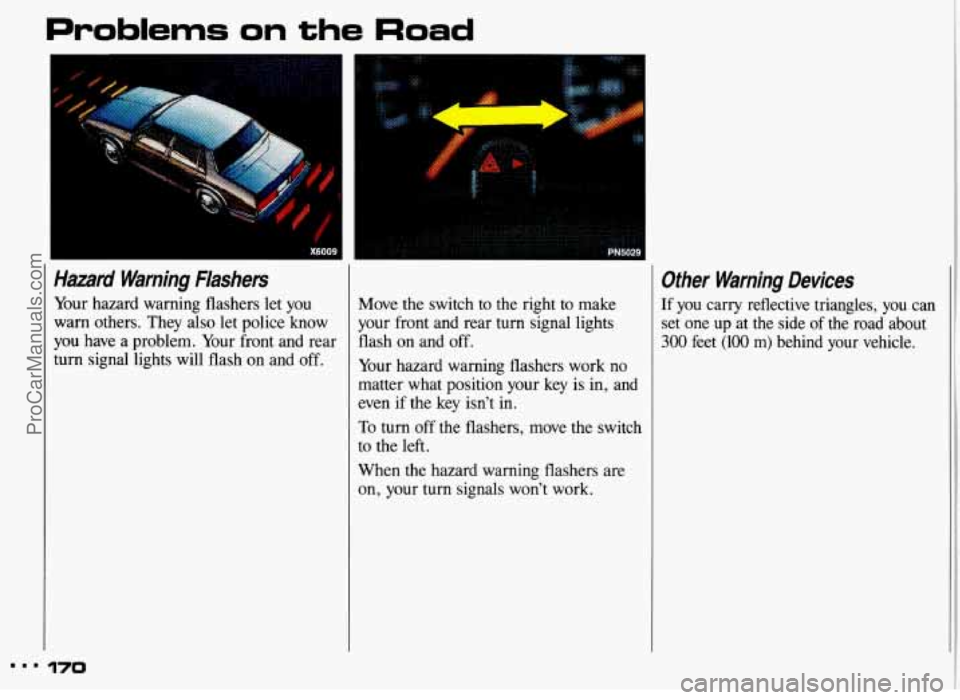1993 PONTIAC GRAND-AM warning lights
[x] Cancel search: warning lightsPage 126 of 306

REVERSIBLE tANE ON MULTtlANE ROADWAY
Many city roads and expressways, and
even bridges, use reversible-lane traffic
control during rush hours.
A red X light
above a lane means no driving in that
lane at that time.
A green arrow means
you may drive in that lane. Look for the
signs posted to warn drivers what hours
and days these systems are in effect.
NO PASSING ZONE
Pavement Markings
Pavement markings add to traffic signs
and signals. They give information to
drivers without taking attention from the
roadway.
A solid yellow line on your
side of the road or lane means
Don’t
Cross.
bur Own Signals
Drivers signal to others, too. It’s not
only more polite, it’s safer to let other
drivers
know what you are doing. And
in some places the law requires driver
signals.
Turn and Lane Change Signals:
Always signal when you plan to turn or
change lanes.
If necessary,
you can use hand signals
out the window:
Left arm straight out
for
a left turn, down for slow or about-
to-stop, and up for a right turn.
Slowing Down: If time allows, tap the
brake pedal once or twice
in advance of
slowing
or stopping. This warns the
driver behind you.
Disabled: Your four-way flashers signal
that your vehicle is disabled
or is a
hazard. See the
Index under Hazard
Warning Flashers.
liffk Ofiiceer
The traffic police officer is also a source
of important information. The officer’s
signals govern, no matter what the
traffic lights or other signs
say.
The next section discusses some of the
road conditions you may encounter.
125
ProCarManuals.com
Page 148 of 306

Tips on Driving in Fbg
If you get caught in fog, turn your
headlights on low beam, even in
daytime, You’ll see-and be seen-
better. Use your fog lights.
Don’t use your high beams. The light
will bounce
off the water droplets that
make up fog and reflect back at you.
Use your defogger.
In high humidity,
even a light build-up of moisture
on the
inside of the glass will cut down
on your
already limited visibility.
Run your
windshield wipers and washer occasionally. Moisture can build up on
the outside glass, and what seems to be fog may actually be moisture on the
outside of your windshield.
Treat dense fog as
an emergency. Try to
find a place to pull off the road. Of course
you want to respect another’s
property, but you might need to put something between you and moving
vehicles-space, trees, telephone poles,
a private driveway, anything that
removes you from other traffic.
If visibility is near zero and you must
stop but are unsure whether you are
away from the road,
turn your lights on,
start your hazard warning flashers, and
sound your horn at intervals or when
you hear approaching traffic.
Pass other vehicles in fog only if you
can see far enough ahead to pass safely.
Even then, be prepared to delay your
pass if you suspect the fog is worse
up
ahead. If other vehicles try to pass you,
make it easy for them.
City Driving
One of the biggest problems with city
streets is the amount of traffic on them.
You’ll want to watch out for what the
other drivers are doing and pay attention
to traffic signals.
Here are ways to increase your safety in
city driving:
Know the best way to get to where you
are going. Try not to drive around
trying to pick out a familiar street or
landmark. Get a city map and plan
your trip into
an unknown part of the
city just as you would for
a cross-
country trip.
Try to use the freeways that rim and
crisscross most large cities. You’ll save
time and energy. (See the next section,
Freeway Driving.
147
... . -
ProCarManuals.com
Page 151 of 306

Your Driving and the Road
Leaving the Freeway (CONT.)
extra time and flash your brake lights (in
addition to your turn signal) as extra
warning that you are about to slow
down and exit.
The exit ramp can be curved, sometimes
quite sharply. The exit speed is usually
posted. Reduce your speed according to
your speedometer, not to your sense of
motion. After driving for any distance at
higher speeds, you may tend to think
you are going slower than you actually
are. For example,
40 mph (65 km/h)
might seem like only
20 mph (32 km/h).
Obviously, this could lead to serious
trouble
on a ramp designed for 20 mph
(32 km/h)!
150
Driving a Long Distance
Although most long trips today are
made on freeways, there are still many
made on regular highways.
Long-distance driving on freeways and
regular highways is the same in some
ways. The trip has to be planned and the
vehicle prepared, you drive at higher-
than-city speeds, and there are longer
turns behind the wheel. You’ll enjoy
your trip more if you and your vehicle
are in good shape. Here are some tips
for a successful long trip.
Before Leaving on a Long nip
Make sure you’re ready. Try to be well
rested.
If you must start when you’re not
fresh-such as after a
day’s work-don’t
plan to make too many miles that first
part of the journey. Wear comfortable
clothing and shoes you can easily drive
in.
Is your vehicle ready for a long trip? If
you keep it serviced and maintained, it’s
ready to go. If it needs service, have it
done before starting out. Of course,
you’ll find experienced and able service
experts in Pontiac dealerships all across
North America. They’ll be ready and willing to help if you need it.
ProCarManuals.com
Page 171 of 306

Problems on the Road
Hazard Warning Flashers
Your hazard warning flashers let you
warn others. They also let police know
you have a problem. Your front and rear
turn signal lights will flash
on and off.
170
Move the switch to the right to make
your front and rear turn signal lights flash on and off.
Your hazard warning flashers work no
matter what position your key is in, and
even if the key isn’t in.
To turn off the flashers, move the switch
to the left.
When the hazard warning flashers are
on, your turn signals won’t work.
Other Warning Devices
If you carry reflective triangles, you can
set one up at the side of the road about
300 feet (100 m) behind your vehicle.
ProCarManuals.com
Page 222 of 306

Engine Coolant
The following explains your cooling system and how to add coolant when it
is low. If you have a problem with
engine overheating, see the
Index under
Engine Overheating.
The proper coolant for your Pontiac
will:
Give freezing protection down to
Give boiling protection up to 262°F
Protect against rust and corrosion.
Help keep the proper engine
-34°F (-37°C).
(128°C).
temperature.
Let the warning
should. lights work as they
What to Use:
Use
a mixture of one-half clean water
(preferably distilled) and one-half
antifreeze that meets
“GM Specification
1825-M,” which won’t damage
aluminum parts. You can
also use a
recycled coolant conforming to GM
Specification 1825-M with a complete
coolant flush and refill. If you use this
mixture, you don’t need to add anything
else.
CAUTION I
A Adding only plain water ta
L pur cooling system can be
dangerous. Plain water, or some
other liquid like alcohol, can boil
bebe the proper coolant mix will.
system is set for the proper coolant
mix. With plain water or the
wrong mix, your engine could get
too hot but you wouldn’t get the
overheat warning, Your engine
could catch fire and you or others
could be burned. Use a 50/50 mix
of clean water and a proper
antifreeze.
Your v&hicle’s coolant warning
221 .
ProCarManuals.com
Page 295 of 306

Buckling Up (see Safety Belts)
Bulb Replacement
Fog Lights
.................. 229
Headlight
.............. .228. 254
Taillight
........... .229. 254
Capacities
& Specifications ...... 251
Carbon Monoxide in Exhaust
.. .66. 67
Cassette Tape Player
Center Passenger Position
......... 28
Chains. Safety
................. 164
Chains. Tire
.............. .193. 238
Changing a Flat Tire
............ 186
Charging System Warning Light
.... 95
“Check Gauges’’ Light ........... 99
Check Oil Light ............... 94
Checking
Brake Fluid
.................. 225
Engine Coolant
............... 222
Engine Oil Level
............. 209
Hydraulic Clutch
............. 220
Power Steering Fluid
.......... 224
Safety Belt Systems
............ 40
Transaxle Fluid
Automatic
................. 216
(see Audio Systems)
Dm. 294
Manual ................... 218
Checking Things Under the Hood
.............. 204
Checks
& Services. Owner ....... 271
Chemical Paint Spotting
.......... 246
Child Restraints
................. 30
Children and Safety Belts
..... .29. 38
Cigarette Lighter
................ 85
Circuit Breakers & Fuses ......... 248
City Driving
................... 147
Cleaner, Air
.............. .214. 257
Cleaning Aluminum Wheels
............ 244
Antenna
..................... 119
Cassette Player and Tapes
....... 118
Compact Discs
............... 119
Fabric
...................... 240
Finish Damage
............... 246
Foreign Material
.............. 245
Glass
...................... 243
Inside of Your Pontiac
......... 240
Leather and Vinyl
............. 242
Outside of Your Pontiac
........ 243
Safety Belts
.................. 242
Sheet Metal Damage
.......... 245
Special Problems
............. 241
Top
of the Instrument Panel ..... 242 Underbody Maintenance
....... 246
Using Solvent Type Cleaner
..... 241
Warnings
...... .239. 240. 242. 244
Weatherstrips
................ 245
White Sidewall Tires .......... 244
Windshield and Wiper Blades
... 243
Climate Control System
.......... 102
Clock. Setting
the ............... 107
Clutch. Hydraulic Adding Fluid
........... .220. 253
Checking Fluid
............... 220
Coin Holder
.................... 84
Comfort Controls
............... 101
Air Conditioning System
....... 103
Climate Control System
........ 102
Defrosting
................... 102
Heater
...................... 102
Ventilation
............ .102. 104
Compact Disc Player
(see
Audio Systems)
Compact Spare Tire ........ .192. 304
Control of a Vehicle
............. 129
Controlled-Cycle Windshield Wipers
. . 80
Convex Outside Mirror ........... 81
Coolant
....................... 221
Checking
& Adding .. .222. 251. 253
Low Coolant Warning Light
...... 93
ProCarManuals.com
Page 296 of 306

Proper Mixture to Use ......... 221
Safety Warnings. About
........ .179. 181. 182. 183
Temperature Gage
............. 93
Temperature Warning Light ...... 92
Thermostat
.................. 223
Corrosion Protection
............ 246
Cruise Control
.................. 70
Cup Holders
................... 83
Curves. Driving
on .............. 136
Customer Assistance Information
. . 279
Daytime Running Lights
......... 75
Defects. Safety. Reporting Dead Battery: What to Do
........ 171
Defensive Driving
.............. 126
(see
Safety Defects)
Defogger. Rear Window .......... 105
Defogging Your Windows
.... .103. 105
Door Locks
.................... 45
Door. Remote Fuel Filler
......... 203
Downshifting
.............. .62. 152
Driver Position
.................. 18
Driving
....................... 121
AtNight
.............. ... 142 City
........................ 147
Controlling a Skid
............. 141
Defensively
.................. 126
Drunken
.................... 127
Freeway
.................... 148
Highway Hypnosis
............ 151
Hill and Mountain
............ 152
In a Foreign Country
.......... 202
In Fog, Mist and Haze ......... 146
In the Rain
.................. 144
Long Distance ................ 150
Loss of Control
............... 140
On Curves ................... 136
Passing
..................... 138
Skidding
.................... 141
Through Deep Standing Water
.... 55
Winter Driving
............... 156
With a Trailer
................ 164
Driving on
Snow or Ice .......... 156
Drunken Driving
............... 127
Easy-Entry Seat
................ 11
Electrical Equipment, Adding
............. .55, 107, 248
Emergencies, Braking
........... 135 Emergencies
on the
Road ......... 169
Emergencies. Steering in
......... 137
Emergency Starting
.............. 171
Emergency Towing
.............. 175
Engine Block Heater
......... .56, 213
Engine Coolant (see
CooZant)
Engine Coolant Temperature Warning
Engine Identification
........ .52. 247
Engine Oil
.................... 209
Additives
.................... 213
Checking
& Adding ........... 209
Disposing of Used Oil
.......... 214
Energy Conserving
............ 212
Filter
.................. .213. 257
Kind of Oil to Use ............. 210
Pressure Gage
................. 95
Warning Light
................ 93
When to Change .............. 213
Engine Overheating
............. 179
Engine Specifications
............ 256
Engine. Starting
................. 52
Automatic Transaxle
........... 53
Manual Transaxle
.............. 53
2.3L Quad 4 Engine
............ 53
3300
V6 Engine ............... 54
295
Light (see Coolant)
ProCarManuals.com
Page 297 of 306

Ethanol in Gasoline ............. 201
Exhaust
Dangerous Gas in
.......... .66. 67
parlang with the Engine Running . .64. 67
Expectant Mothers. Use of Safety Belts
................... 22
Expressway Driving
.............. 148
Extender. Safety Belt
.............. 38
Exterior Appearance
(see Appearance Care)
Fabric cleaning
(see Appearance Care)
Fan Warnings ....... .172. 173. 181. 206
Filter. Oil
................. .2l3. 257
Finish Damage
................. 246
Filling the Fuel Tank
.... .203.252.
304
Flash-to-hs
.................... 76
Flashers. Hazard Warning
......... 170
Hat
Tire ...................... 185
Flooded Engine .................. 54
Flow-Through Ventilation System
.... 106
Fluid Brake
.................. .225. 253
Capacities
................... 251 Hydraulic Clutch
......... .220. 253
Power Steering
....... .224. 252. 253
Transaxle
Automatic
......... .216. 251. 253
Manual
........... .218. 251. 253
Windshield Washer
........ .80. 224
Fluids
& Lubricants ......... .253. 276
Fog. Driving
in ................. 146
Fog Lights
................. .77. 229
Freeway Driving
................ 148
Fuel
.......................... 199
Alcohol
in Fuel ............... 201
Capacity
.................... 201
Exhaust Warnings
.......... .66. 67
Fuels with Alcohol ............. 201
Gage
........................ 92
In Foreign Countries ........... 202
Remote Fuel Filler Door
........ 203
Requirements
................. 199
Fuse Usage Chart
............... 249
Fuses
& Circuit Breakers .......... 248
French Language Manual
........... 2
Filling Your Tank
..... .203. 252. 304 Gages
Coolant Temperature
............ 93
Fuel
........................ 92
oil Pressure .................... 95
Tachometer
................... 91
Voltmeter ..................... 96
Garment Hook
.................. 84
Gas Station Information
......... 304
Gasoline
...................... 199
Gasoline Tank, Fdlmg Your
. .203,252, 304
Gear Positions
Gearshift Lever
Glove Box
...................... 50
Graphic Equalizer (see Audio Systems)
Gross Axle Weight Rating (GAWR) . . 230
Gross Vehicle Weight Rating
(GVWR)
................... 230
(see Sh$mg the Transaxle)
(see ShiJlting the Pamade)
Halogen Bulbs ........... .22 7. 254
Hazard Warning Flashers
......... 170
Head Restraint
.................. 11
Headlight
& Taillight. Removing and
Replacing
.......... .228. 229. 254
296
ProCarManuals.com